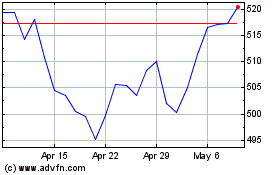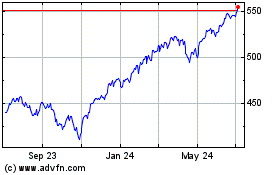Fed Crystal Ball: Clear or Cloudy? - Cook`s Kitchen
April 26 2012 - 8:00PM
Zacks
To many, the Federal Reserve and its monetary policies seem
mysterious and ill-defined. How do they decide on a policy that
sees the necessity for near-zero interest rates for the next two
years? What exactly is in their crystal ball?
One thing the Bernanke Fed has done well to provide
clarity and prevent confusion is to publish the economic
projections of the FOMC members along with each post-meeting
statement. In a few PDF pages, we get simple charts and tables on
three important areas of forecast: GDP, unemployment, and
inflation.
Seeing What the FOMC Sees
Looking at these 3 charts helps us see what the
world's most important economists are using as decision metrics for
setting interest rates and proposing, or opposing, more
quantitative easing.
I won't try to interpret these charts too much, as
they practically speak for themselves. They appear on page 2 of a
5-page PDF on the FederalReserve.gov website and are titled
"Central tendencies and ranges of economic projections, 2012-14 and
over the longer run." The PDF is tricky to find, and so I assume
most people don't ever see it. That's why I think it's important to
share.



Okay, I know I said I wouldn't interpret, but I
can't help it. Allow me to summarize what the FOMC sees in its own
forecasts that makes it lean as a policy-setting body toward
keeping interest rates very accommodative for nearly two more
years:
First, most members see GDP struggling to get above
3% in the next two years.
Second, while they see unemployment falling below
8%, they don't see it picking up momentum to carry it below 7% very
soon.
Third, despite what common sense might seem to
dictate in an era of extraordinary accommodation (QE), inflation is
forecasted to stay below 2% for quite a while. This is the Bernanke
gambit that deflation is the far worse evil and that it is far
better to tempt too much inflation than too little.
This last point is certainly the most
controversial. Some might say that the Fed has a conflict of
interest here. While they want to backstop the economy and the
stock market, they don't want to acknowledge that they could
actually be fanning the flames of an inflation wildfire.
The next few years will certainly be the most
interesting in terms of the evolution and impact of Fed policy. We
can definitely say that the Bernanke Fed is winning the war against
deflation. But we have no idea what things will look like three
years from now in terms of inflation.
Fed footnotes to graphs:
1. The central tendency excludes the three highest
and three lowest projections for each variable in each year. 2. The
range for a variable in a given year includes all participants’
projections, from lowest to highest, for that variable in that
year. 3. Longer-run projections for core PCE inflation are not
collected.
A Very Positive Twist
Market participants expecting more QE this week, or
some extension of Operation Twist, were sorely disappointed. They
should not have been surprised though because this Fed is very good
at telegraphing its views, intentions, and actions.
What this Fed does surprise us with is more and
more transparency. Starting this year, they began showing where the
FOMC voting was spread out in terms of the policy decisions. Below
are the graphs included in the PDF.


Diversity and Debate
In the fall of 2011, I started to note the
"dissent" on the FOMC from certain members who were becoming more
hawkish. I thought this was great news, but not because I was eager
to see rates rise and prevent inflation. I agree with current Fed
policy that beating deflation is still the major battle.
The dissent and debate is good because it means our
best economic minds are hard at work crunching the data and arguing
amongst themselves about where we stand. True, there may be
PhD-size egos involved as well. But we want this debate happening
at this time and we want to know as much about it as we can.
One way to keep informed is to read all the
speeches of all the Fed Board Members and Bank Presidents, whether
they are FOMC voting members or not. That's a lot of work in some
weeks where there might be a half-dozen speaking. But, contrary to
simple opinion, it's not just Ben Bernanke's show and we need to
understand how the other economists at the most important bank in
the world think.
The only thing the Fed could do now for more
transparency is put the names of the voters on each forecast and
policy firming stance. The FOMC will always stand in the light of
sharp criticism. But why should Ben take all the heat?
I think he should get a lot of credit for pushing
policy to its current extremes, especially when we needed it in
2008 and 2009, and in 2010 and 2011 when we needed it maintained.
And now the other members will become ever more important as we can
realistically start looking for the QE exits... at least a year
from now, anyway.
Kevin Cook is a Senior Stock Strategist with
Zacks.com
To read this article on Zacks.com click here.
SPDR S&P 500 (AMEX:SPY)
Historical Stock Chart
From Mar 2024 to Apr 2024

SPDR S&P 500 (AMEX:SPY)
Historical Stock Chart
From Apr 2023 to Apr 2024
